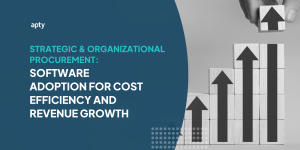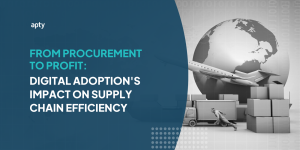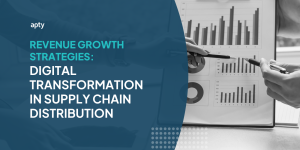“Retailing is all about the art of getting the customer to pay full price and still leave happy.” – SAM WARLTON, CEO of Walmart
Evolution of the Retail Industry
Retail Industry History to Present Day
From the bartering system of ancient Mesopotamia in 6000 BC to the instant digital transactions and gratification of online shopping, the retail industry tends to lead the way for digital transformation trends. Money became the driving force in commerce transformation with the introduction of currency around 5,000 years ago with the Mesopotamian people. Unlike the restricted healthcare and government industries, the retail industry keeps up with competition through the digital transformation without the burdens and delays of bureaucracy, heightened security, and red tape.
As economies grew and societies developed, so did the retail industry. Brick-and-mortar stores emerged as a popular shopping destination, with department stores leading the charge. These large-scale establishments offered customers a wide variety of products under one roof, making it convenient for them to shop. But now, even brick-and-mortar stores find themselves outdated under the convenience of technological advancements, virtual dressing rooms, and instant deliveries with a click of a mouse.
Over time, technology played a significant role in transforming the retail landscape.
Relevant Read: Digital Transformation: How Technology is Changing Business
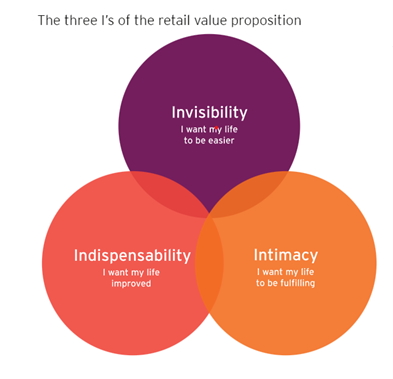
Source: EY
Retailers are now expected to provide seamless omnichannel experiences that integrate both online and offline shopping methods. The influx of technology impacts supply chains, business transactions, consumer behaviors, marketing strategies, and more. Retailers face an urgent need to transform their tech architecture and operating model to stay competitive in the market. According to a recent UBS report, 80,000 retail stores will close in the United States by 2026.
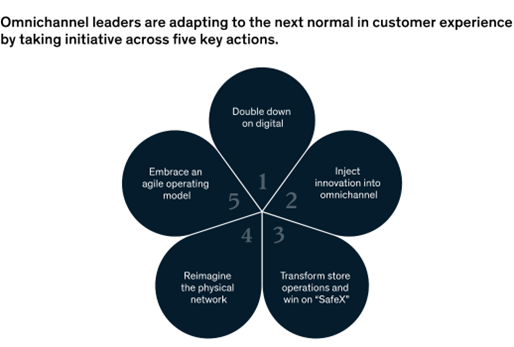
Source: McKinsey
Furthermore, retailers have also started investing in data analytics tools to gain insights into customer behavior patterns and preferences. By leveraging these tools, they can offer personalized recommendations and targeted promotions to improve customer engagement and loyalty. Additionally, contactless payment options have become more prevalent due to the ongoing COVID-19 pandemic, encouraging retailers to adopt new payment technologies like QR codes or mobile wallets. According to McKinsey, during the pandemic, China saw a 30 percent decline in grocery transactions but a 69 percent increase in average transaction value.
As we look ahead at the future digital evolution of the retail industry, many exciting opportunities lie ahead for forward-thinking companies that embrace innovation wholeheartedly. With emerging technologies like virtual reality (VR), augmented reality (AR), and artificial intelligence (AI) becoming increasingly mainstream, there is no limit to what creative minds can achieve when combining them with their existing business models.
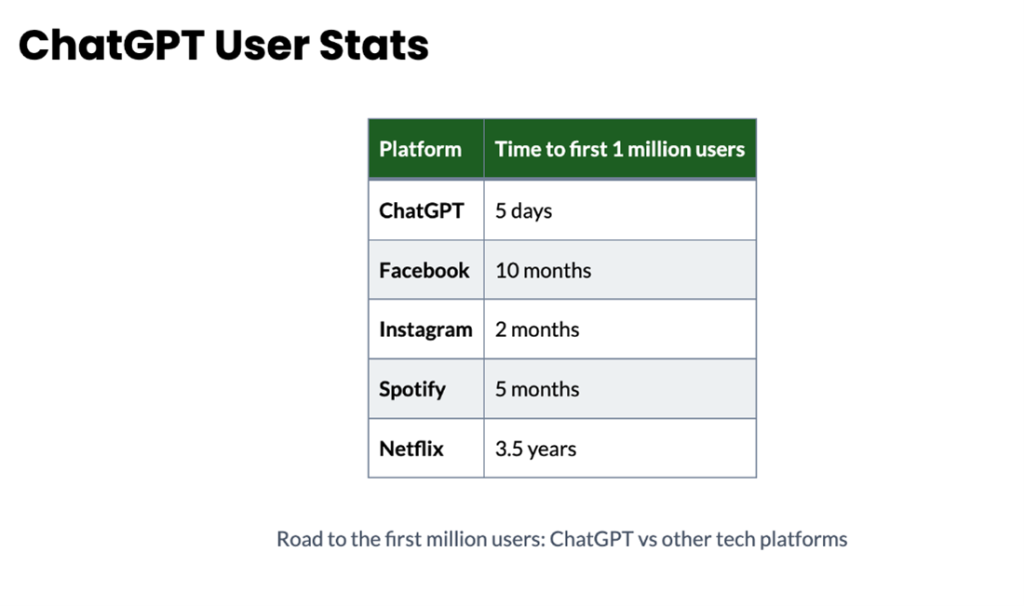
Source: https://nerdynav.com/chatgpt-statistics/
With the generous addition of open-source APIs, like the public launch of ChatGPT in November 2022, the digital industry has seen an exponential acceleration in advancements that will have an effect on the retail industry. To put things into perspective, the timeframe to the first 1 million users for ChatGPT was done in a fraction of the time of past digital advancements that changed businesses globally.
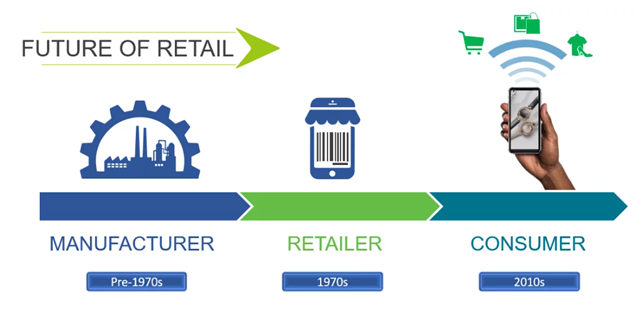
Source: The Digital Transformation People
In 2021, industry expert Ming-Chi Kuo predicted that Apple would replace the iPhone with an augmented reality device by 2032. The possibilities are endless!
The Age of Digital Transformation
The world is currently experiencing a period of profound change driven by the rapid advancement of digital technology. This new era, ‘The Age of Digital Transformation,’ refers to how businesses adapt to technological advances. In today’s globalized economy, companies must be able to adapt quickly to new technologies if they want to remain competitive.
Amidst the current wave of technological advancements, digital transformation (DT) has become a buzzword in various industries.
Relevant read: The future in the age of digital transformation.
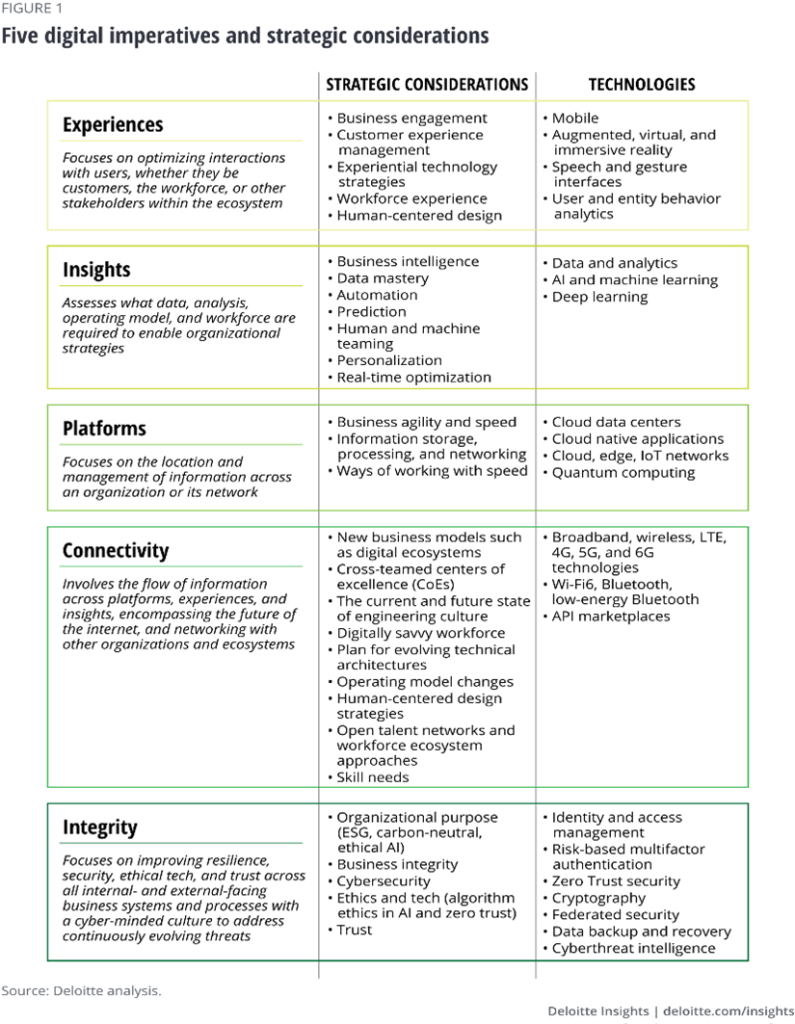
What is Digital Transformation?
Digital Transformation (DT) refers to implementing technology-driven strategies to improve business processes and operations. In simpler terms, it is about leveraging new technologies such as cloud computing, artificial intelligence, and big data analytics, among others, to drive innovation and achieve better outcomes.
Digital transformation represents more than just an upgrade in technology; it requires fundamental organizational structure, processes, and culture changes. Companies that do not embrace this shift risk being left behind as their competitors innovate and accelerate ahead. Embracing digital transformation brings significant benefits such as increased efficiency, improved customer experience, and even access to entirely new markets.
To understand the significance of Digital Transformation in today’s world, consider this anecdote:
Over a decade ago, Blockbuster filed for bankruptcy in 2010 with almost $1 billion in debt due to its inability to adapt to the changing market trends. The emergence of online streaming platforms like Netflix posed a significant threat to their traditional model of renting DVDs through stores. Dish Network bought its remaining 1,700 stores the next year, and by 2014, the last of its 300 company-owned stores were closed. Netflix created a better business model. Redbox kiosks and the whole digital phenomenon eliminated the need for consumers to make a separate trip to a DVD store.
Netflix listened to the market’s desire for convenience. Millennials evolved to need instant gratification thanks to other digital advancements like mobile phones. Catering to their needs and wants, Netflix capitalized on what was to become the top consumer generation of 2020. As a result, Blockbuster failed to keep up with customer expectations and eventually lost relevance in the industry. This story highlights how businesses that fail to embrace digital change risk becoming obsolete over time.
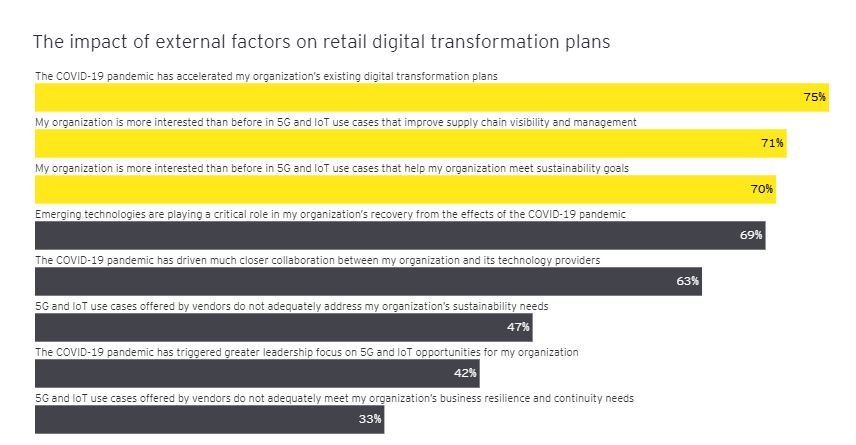
Source: EY
As we move forward into an increasingly digitized future, embracing Digital transformation improves longevity, scalability, and desirability for organizations hoping to remain competitive and relevant in their respective markets. Software companies are leading the way in adopting these changes while paving the path for other industries looking to embark on similar journeys toward success.
Real-life Examples of Software Companies Undergoing Large DT Initiatives [H3]
- Microsoft: The company’s CEO Satya Nadella made it his mission to transform Microsoft into a “mobile-first, cloud-first” company. This involved reorganizing the company’s structure, investing heavily in AI and cloud technology, and partnering with other industry players, such as Adobe, to offer more comprehensive solutions for customers.
Relevant Read: Apty’s Strategic Partnership with MS Dynamics
- LeewayHertz: They provide insights on digital transformation and how it can be achieved. Additionally, they offer services such as machine learning, artificial intelligence, virtual reality app development, and more. Listed as one of the top digital transformation companies and consulting firms in 2023 suggests that LeewayHertz maintains relevance and dedication to large digital transformation initiatives propelling them to the top of enterprises’ lists for companies to work within 20233.
- Adobe Systems Inc: Transformed from selling boxed software to a cloud-based subscription service provider making their product more accessible. Adobe no longer sells or distributes boxed software; its programs are only available via subscription. The transformation was described as radical and remarkable, and Adobe now claims to be a cloud powerhouse serving other Fortune 500 companies. The company’s Creative Cloud is a way to sell its software as a subscription service, but it also entered the CRM space in recent years. Although newcomers, they already find themselves at the top of reviews and feature lists, competing with industry strongholds like Salesforce.
Also Read: 5 AI Trends that Are Changing the Face of Retail
However, implementing digital transformation is not without its challenges. It requires significant investments in infrastructure, talent acquisition, and training, and change management processes… The list goes on. Nonetheless, businesses that successfully implement digital transformation reap significant benefits, including increased efficiency and productivity.
Implement digital transformation reap significant benefits, including increased efficiency and productivity.
Implementation Strategy for Digital Transformation
As technology continues to evolve, companies must adapt and implement new strategies to stay competitive in their respective industries. A well-thought-out implementation strategy for digital transformation ensures a successful shift toward a more efficient and effective organization that can leverage technology to drive growth.
1. Achieving company clarity: Identifying areas where technology can improve operational efficiency, enhance customer experience, or create new revenue streams.
2. Develop a roadmap: Once these areas have been identified, outline how the technology will be implemented across the organization’s users, software applications, and/or departments.
3. Change management: Change management plays a critical role in ensuring successful digital adoption. Employees must be trained on new technologies and processes to perform their roles effectively.

4. Communication: Resistance to change is common when implementing new technology., Communication throughout the digital transformation process ensures everyone understands the when, where, and why around the change(s) made and what benefits they bring to the company, team, and their personal role.
5. Collaboration: Involving stakeholders, subject matter experts (SMEs), and different departments helps address the pertinent goals that meet company objectives and initiatives. Collaboration between IT teams and business leaders is vital during the planning phase of digital transformation initiatives. Business leaders must provide insights into their operations, while IT teams bring expertise around technical capabilities. Collaboration ensures alignment between technological solutions and organizational goals leading toward achieving desired outcomes.
It is important to note that organizations should remain agile throughout the process because digital transformation projects are not one-time events but rather continuous improvement efforts requiring ongoing maintenance and attention over time. McKinsey & Company identifies ten traps that derail digital transformation.
History of Walmart
Sam Walton founded Walmart in Rogers, Arkansas, in 1962. The original name of Walmart was “Walton’s Five and Dime.” The first store opened on July 2, 1962, and the company officially incorporated Wal-Mart Stores, Inc. that same year. Walmart initially focused its growth in rural areas to avoid direct competition with other retailers. By 1968, the Walton family owned 24 stores and had achieved $12.7 million in sales.
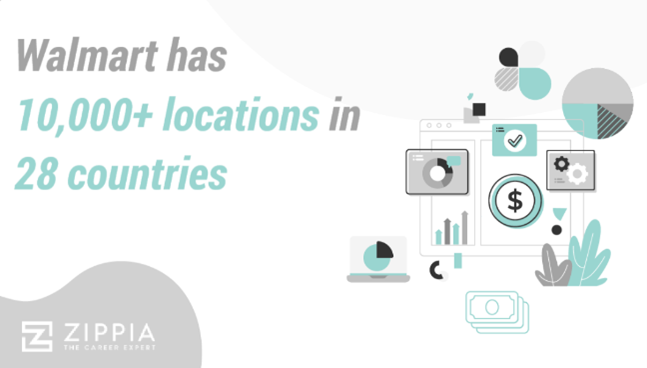
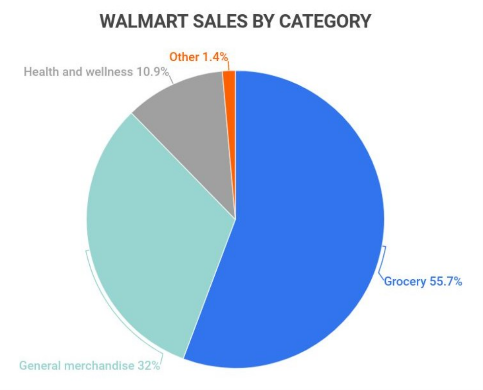
Source: Zippia
Walmart is no stranger to business and digital transformations. As the world’s largest retailer, Walmart drives innovation past and present. In recent years, Walmart aimed to transform digitally, bringing innovations that save its customers time and money, and change how work is carried out inside the company.
Walmart offers technologies and capabilities to help other businesses navigate their own digital transformation. They implemented several innovative technologies, such as a tech platform that uses automation and machine learning to turn data into usable insights. The company also upgraded its mobile capabilities and added lists, returns, robots, associates, and automation to its digital transformation efforts in retail.
Walmart continues leveraging technology such as machine learning, cloud-powered checkout, and pickup capabilities to offer their customers and vendors more convenience to stay competitive. Additionally, the company uses drones and autonomous vehicles for deliveries and added automated micro-fulfillment to dozens of stores. Finally, workers at Walmart stores in the United States use augmented reality on their devices to read the labels of boxes tucked away in warehouses.
“There is only one boss. The customer. And he can fire anybody in the company from the chairman on down, simply by spending his money somewhere else.”
– Sam Walton
Salesforce

Source: Freepick
In today’s fast-paced business world, keeping track of customer interactions and managing sales activities can be daunting. That’s where Salesforce comes into play. This powerful CRM platform, an order-to-cash solution, revolutionized business operations by streamlining processes, boosting productivity, and enhancing customer relations. Whether a small startup or a large enterprise, Salesforce offers various tools and features to help you manage your sales pipeline effectively.
Salesforce established itself as a top enterprise software suite that operates as a CRM and ERP system across multiple cloud-based platforms. Salesforce provides a Platform-as-a-Service (PaaS) offering consultant services for its customers to establish operational activities in the cloud environment. Founded in 1999 by Marc Benioff and Parker Harris, it became the largest CRM platform in the world. Many corporations worldwide utilize it to organize business-related information, including sales records, market research data, report categorization, and other relevant content management aspects needed for optimal performance.
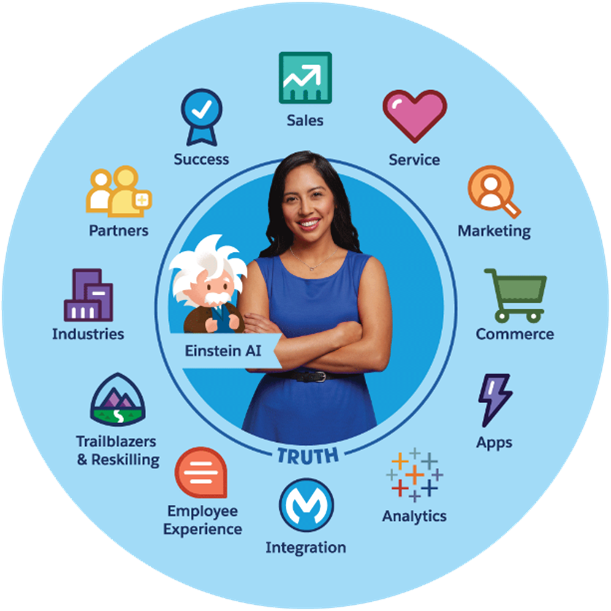
Source: Salesforce
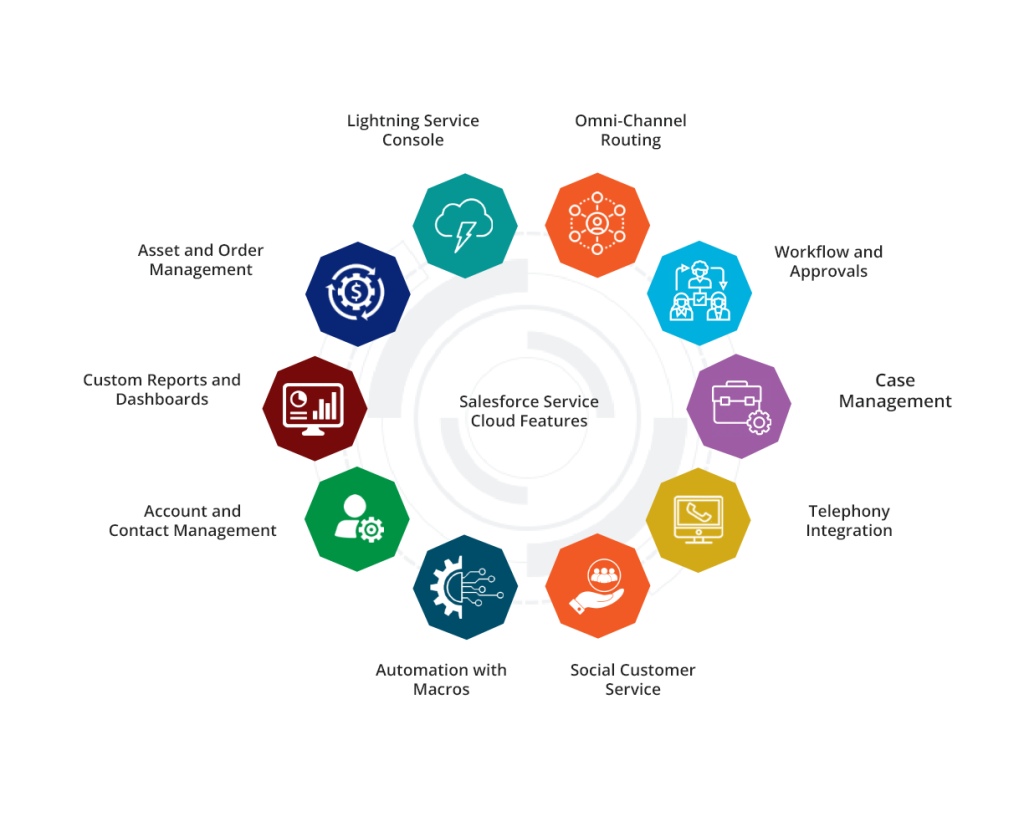
Source: Thompson Data
The company’s CEO Marc Benioff acts as a huge proponent of Salesforce and takes great steps toward scaling the company. Salesforce has been named the #1 CRM provider for consecutive years, still topping the ranks in its ninth year in 2022. It also ranked #1 in CRM market share by International Data Corporation (IDC) for eight consecutive years. These rankings demonstrate Salesforce’s continued success and leadership in the CRM industry.
Salesforce stands out from other CRM providers as it garnered early traction as they continued to push the digital envelope to provide a bird’s eye view of the sales pipeline to help gauge and determine sales opportunities and allow businesses to leverage customer information to increase sales.
Before we dive into the big Walmart/Salesforce announcement this year, let’s review the Salesforce features. It’s no wonder the two joined forces to create the ultimate end-user experience.
Learn more about Salesforce: How can You Maximize Salesforce ROI?
Benefits of Salesforce
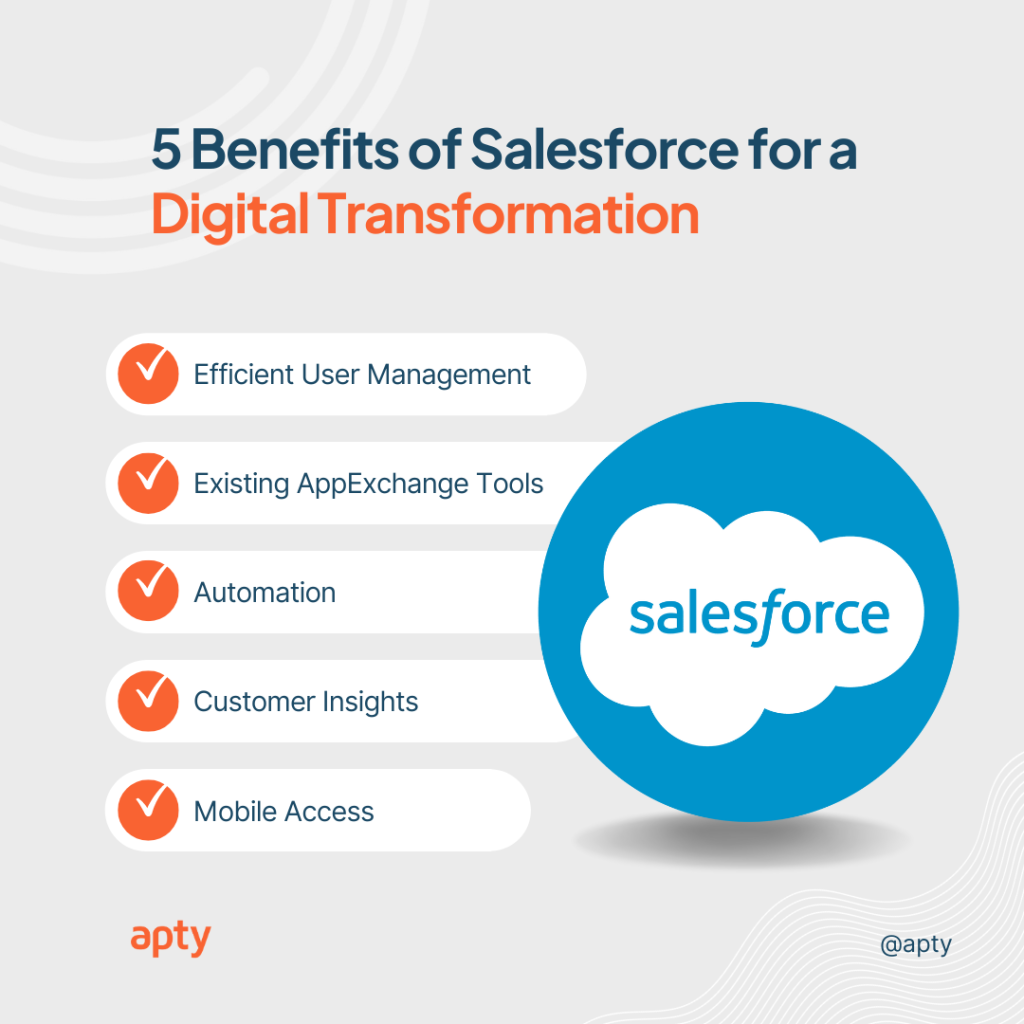
1. Efficient User Management: Salesforce allows users to easily manage channel users, company teams & external contacts via user profiles. Salesforce can synchronize user profiles with essential apps to create a single platform. Salesforce administrators can customize URLs using the ‘MyDomain’ feature. It helps to brand the URLs and make them consistent with the business’s logos, images, and other marketing materials.
2. Automation: Salesforce allows business owners to automate and standardize important processes. Salesforce offers many options for workflow automation, including pre-set rules and graphical procedures that it customizes to fit your needs. Automating simple tasks allows sales teams to work more efficiently and save time and money.
3. Existing AppExchange Tools: Salesforce’s AppExchange has many tools that you can use to improve what Salesforce can do. It’s a marketplace of thousands of useful applications. AppExchange apps are special tools that help manage your business processes, workflows, and customer relationships. They have unique features that businesses of all sizes use to implement comprehensive solutions quickly.
4. Customer Insights: Salesforce’s machine-learning intelligence engine gives businesses real-time customer insights. A company can learn much from its customers with the Customer Relationship Platform. It helps analyze customer behavior, measure satisfaction, and predict opportunities.
5. Mobile Access: Salesforce’s mobile feature lets you stay updated on customer information wherever you are. It makes sure all data is always current. Salesforce has a mobile platform with solid cloud tools. Users can create their apps to fit their needs. Users can access information and reports and take critical action anywhere, anytime. Salesforce’s platform is excellent for building and deploying mobile apps. It’s #1 for businesses.
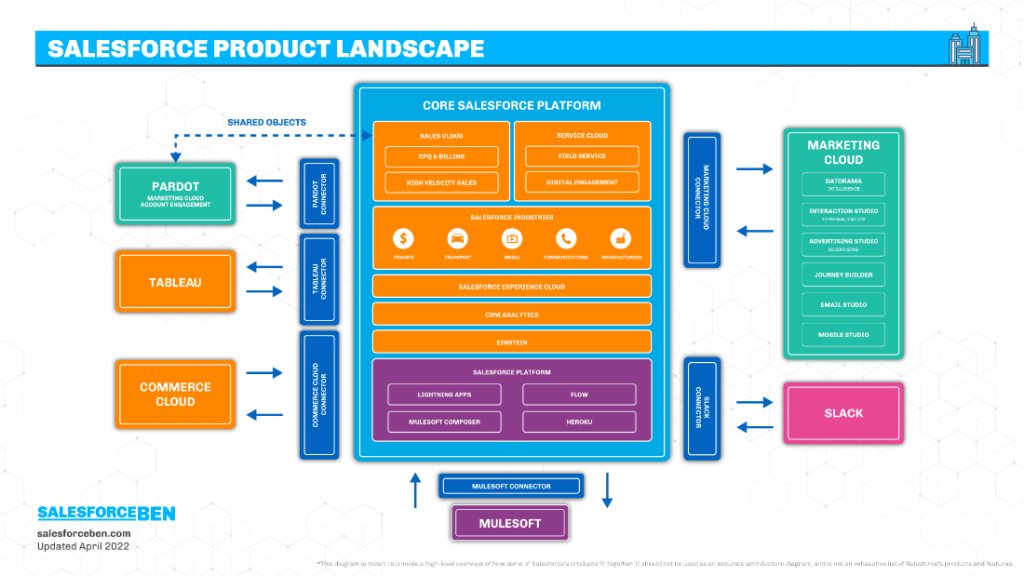
Source: Salesforceben
Latest Salesforce initiatives
- https://www.salesforce.com/news/
- Lightning Order Management
- AppExchange (originally introduced in 2005
- Salesforce for Retail
- “Jen’s Top Spring ’23 Release Features for Admins and Users”
- “22 New Salesforce Features Everyone Should Know” by SalesforceBen
- New Salesforce for Retail Innovations Help Personalize Every Shopping Moment
- Salesforce Gets into Retail Media (2023)
Salesforce and Walmart’s Partnership Announcement
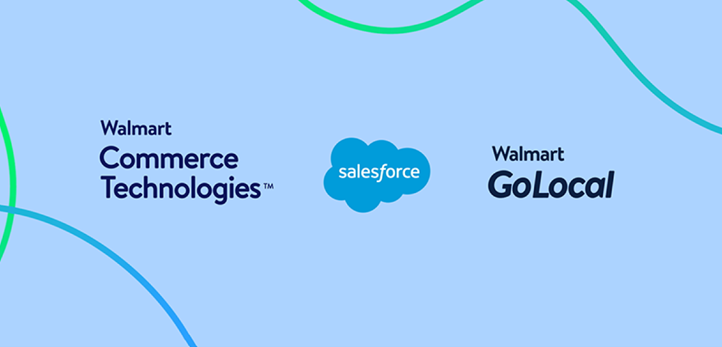
Walmart Commerce Technologies and Salesforce recently announced an industry-shaking partnership that will completely transform how shoppers interact with the retail giant. The partnership will allow retailers to use Walmart’s GoLocal delivery service, which drops off purchases at customers’ doors, and Store Assist. This Walmart app helps users manage and track orders and speed up the handing over of online orders to customers or delivery drivers.
Retailers can leverage the same innovative and scalable technologies that power Walmart’s omnichannel capabilities, drive efficiency, and ensure that every purchase quickly gets into the hands of the shopper – no matter where they are. The partnership will enable personalized and accessible commerce experiences with real-time order visibility and reliable local pickup and delivery. Retailers who use Salesforce’s e-commerce platforms to host and manage their websites will be able to avail of Walmart’s GoLocal and Store Assist services to provide faster order pickups and same or next-day deliveries to online customers.
They developed a new and helpful digital experience for e-commerce retailers who want to drive efficiency and profitability across all channels. The two companies have allied to improve customer experience, expand digital capabilities, and strengthen data and analytics. This partnership will enable Walmart to gain access to Salesforce’s customer relationship management (CRM) platform to understand customer preferences and trends better.
What specific services will Salesforce and Walmart offer together?
As a result of the Salesforce and Walmart partnership, retailers will receive technologies and services that will enhance their e-commerce capabilities.
- Walmart GoLocal is a service that provides same-day delivery for businesses of all sizes.
- Walmart Commerce Technologies Store Assist is a service that helps optimize in-store fulfillment and is available to Salesforce clients. It is available through Salesforce (CRM) AppExchange.
- Enable Buy Online and Pick Up In-Store (BOPIS): Walmart Commerce Technologies’ Store Assist enables Buy Online and Pick Up In-Store, leveraging local stores as fulfillment centers for efficient order picking and seamless handoff experiences to customers or delivery drivers.
- Manage Local Deliveries: Walmart GoLocal offers scalable local delivery solutions, ensuring reliable same-day delivery under a white-label experience. Retailers can maintain their brand’s customer experience while utilizing Walmart’s delivery infrastructure.
- Drive Efficiency and Profitability Across the Omnichannel Shopping Journey: Walmart’s Commerce Cloud and Order Management help retailers streamline and enhance the omnichannel shopping journey. The platform integrates AI and real-time data to provide connected, personalized customer experiences while managing their shopping experience across various channels.
The partnership will also offer last-mile delivery services to customers. Walmart’s scalable technologies like machine learning, cloud-powered checkout and pickup capabilities, robotics, big data, and artificial intelligence will be available to retailers through the partnership with Salesforce.
What does this partnership mean?
This partnership will help Walmart access Salesforce’s leading cloud-based technology, enabling them to optimize their operations and customer experiences. For Salesforce, the partnership provides a platform to expand its customer base and reach more customers. It promises to revolutionize the retail industry and will undoubtedly have a lasting impact.
This partnership gives smaller retailers a competitive edge and the ability to gain access to in-house delivery solutions they otherwise could not afford. With options like seamless online experiences, streamlined fulfillment options, and omnichannel solutions, Salesforce and Walmart changed the retailer game.
“With the combined power of Walmart and Salesforce, retailers can drive success with best-in-class technology to advance their omnichannel capabilities, drive efficiency, and ensure that every purchase quickly gets into the hands of the shopper – no matter where they are.”
– ROB GARF, VP AND GM OF RETAIL, SALESFORCE
By combining the strengths of both companies, retailers can enhance their omnichannel capabilities, optimize operational efficiency, and ensure fast delivery of purchases to customers regardless of location. The partnership aims to provide retailers with best-in-class solutions to meet the retail industry’s evolving demands and deliver customers a seamless shopping experience.
Salesforce CEO Marc Benioff said that this partnership is part of his company’s goal to drive efficiency and profitability across the omnichannel shopping journey.
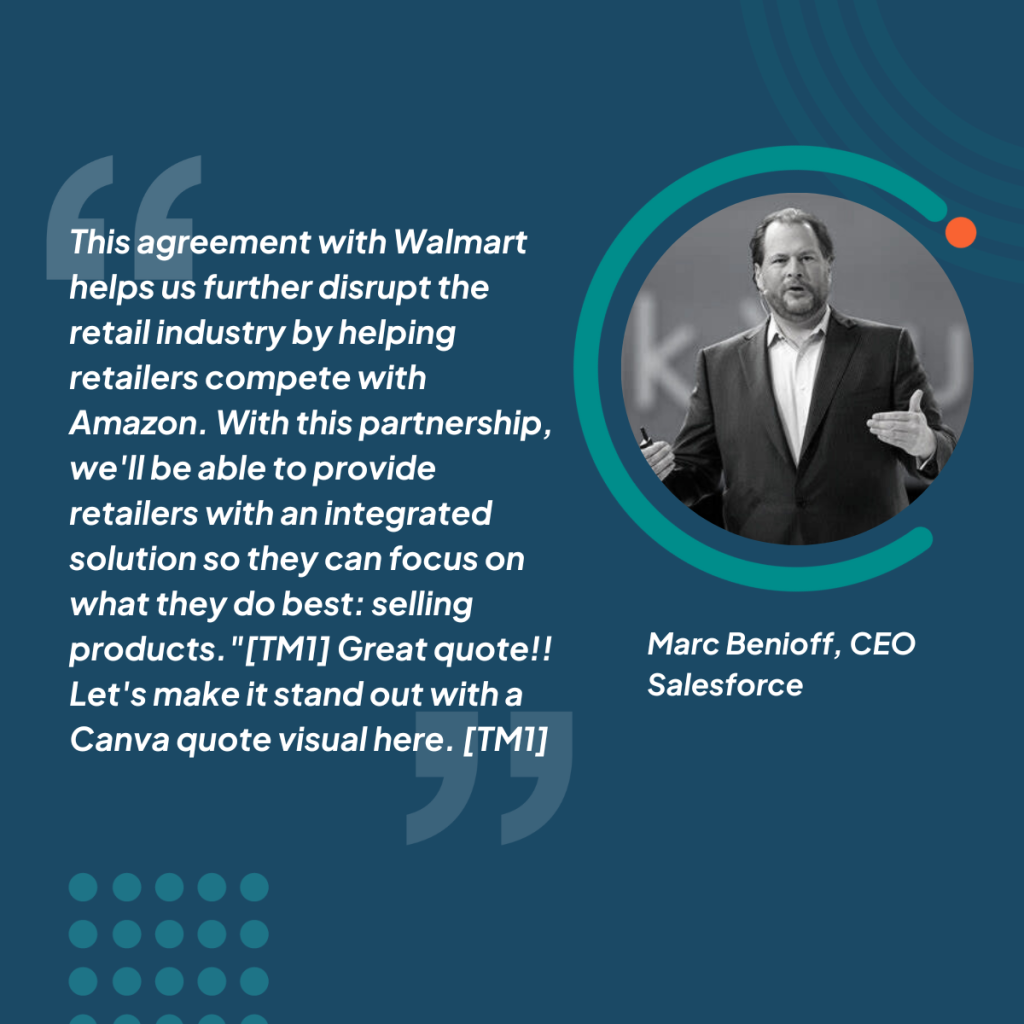
Salesforce and Walmart could significantly disrupt the retail industry and increase competition.
Although Walmart has a reputation for putting local retailers out of business, the partnership with Salesforce could give smaller retailers a significant advantage. Walmart’s entry into the cloud wars with a series of SaaS-based retail and commerce solutions will inevitably compete with Microsoft, Salesforce, Oracle, and SAP offerings.
What should Salesforce and Walmart competitors learn?
Salesforce and Walmart are two significant industry players – cloud computing and retail. With their strong brand presence, extensive customer base, and advanced technology, they have dominated the market for years. However, their competitors must pay attention to them and must stay vigilant to compete effectively.
Salesforce has pioneered cloud computing with its advanced software solutions for customer relationship management (CRM). Its products have been widely adopted by businesses of all sizes, from startups to large enterprises. The company has consistently invested in R&D and acquired new technologies to enhance its offerings further. It has given Salesforce an edge over its innovation and product development competitors. As a result, Salesforce’s competitors must keep pace with its advancements and constantly improve their products to stay relevant.
Similarly, Walmart’s dominance in the retail industry is undisputed. The company’s massive scale and efficient supply chain have helped it offer products at low prices while still maintaining quality. Walmart’s recent investments in e-commerce have also given it an edge in the digital space. Its acquisition of Jet.com and partnerships with Google and other tech giants have made it a formidable player in online retail. Competitors must keep a close eye on Walmart’s strategies and adapt accordingly.
Salesforce and Walmart have also invested heavily in AI and machine learning technologies. Salesforce’s Einstein AI platform has been integrated into its CRM software to provide predictive analytics and personalized recommendations. Walmart has been using AI to optimize its supply chain and improve customer experience. These investments will likely give them an even more significant advantage over their competitors in the future.
The success of Salesforce and Walmart can be attributed to their constant innovation and investment in new technologies. Their competitors cannot afford to ignore these giants in their industries and must stay vigilant to keep up with their advancements. By doing so, they can compete more effectively and offer innovative solutions to their customers.
How this partnership impacted Salesforce and Walmart investors
This partnership announcement, meant to act as a retail industry disruptor, weighed little on stock prices for Walmart but inspired investors in both companies.
Since the announcement, Walmart’s stock has remained stagnant in comparison to Salesforce’s astonishing rise.
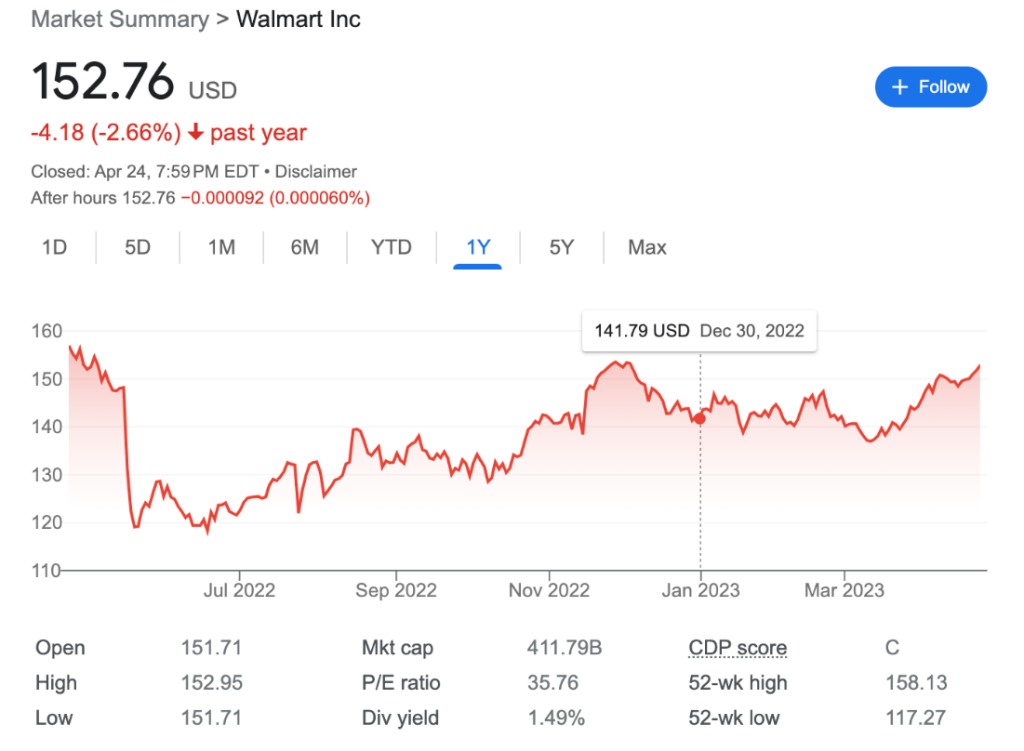
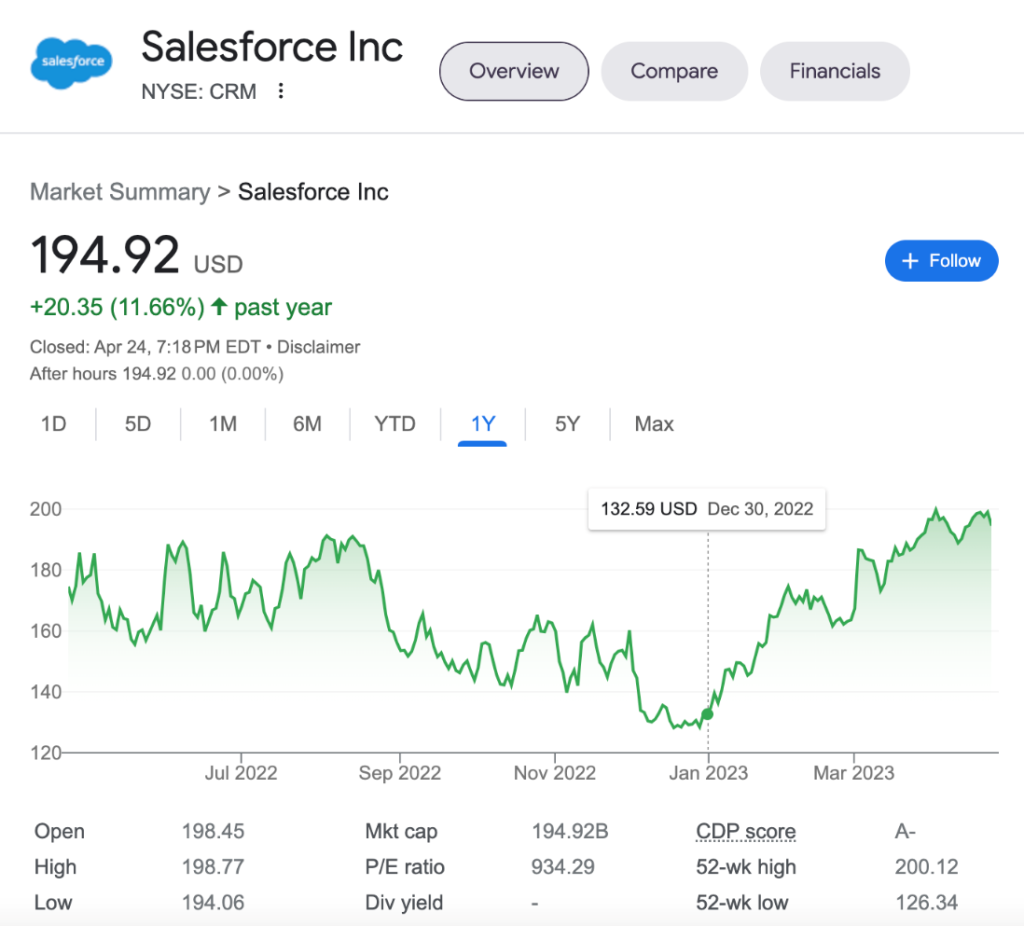
Many investors of Salesforce have watched their stock prices increase since the partnership announcement. As the company takes new steps into the retail industry, this will open up more growth opportunities and efficient services for its customer base. Although “Wall Street isn’t sold on the concept as a money maker yet,” we wait to see the effect on the retail industry as a whole.
Since around 2014, Salesforce dug into the retail industry and continues to drive change. Their marketing efforts clearly show a positive impact and maybe a learning experience for Walmart. Tech-savvy giants like Salesforce find these tech announcements beneficial due to their agile structure, while Walmart battles the logistics of brick-and-mortar constraints and overhead. Other factors like change management, digital adoption, and subject matter experts may be a factor in their opposing stock prices.
By leveraging their collective resources and expertise, these two companies aim to continue their digital disruption to make an impact on others and their revenue stream.
How to Optimize Salesforce for Retail
Clearly Salesforce is doing something right. Luckily, their API allows for helpful and beneficial SaaS application solutions to plug in, sit on top, or integrate directly into their modules.
Salesforce is a powerful tool that can help retailers manage customer relationships, improve sales processes, and increase revenue. However, implementing and updating Salesforce can be a complex and time-consuming process.
Digital Adoption Platform (DAP) has become an increasingly popular solution for retailers looking to streamline their Salesforce implementation process.
Read More: DAP for Salesforce
1. DAP as a solution to help retailers implement Salesforce
Implementing Salesforce can be a daunting task, especially for retailers who may need more technical expertise or resources to do so. It is where Digital Adoption Platforms (DAP) come in handy. A DAP provides step-by-step guidance and interactive support to help retailers seamlessly implement Salesforce into their workflow.
By using a DAP, retailers can reduce the time it takes to implement Salesforce while increasing efficiency and accuracy. The platform offers customized training modules to equip employees with the knowledge and skills to navigate Salesforce confidently. Additionally, the platform provides real-time feedback and analytics that allow retailers to track progress and identify improvement areas.
Overall, using a DAP as a solution for implementing Salesforce reduces costs, minimizes errors, and accelerates the adoption of new technology. It empowers retailers to maximize their investment in Salesforce while freeing up valuable time for other essential tasks.
Read more: Guide to Salesforce Implementation
2. DAP as a Solution to Update Salesforce
One of the retailers’ biggest challenges is keeping up with the constant updates and changes to Salesforce. As new updates are released, ensuring that all employees are trained on how to use the new features effectively can be challenging.
DAPs effectively allow retailers to update the Salesforce without disrupting their workflow. With DAPs, employees can quickly learn about and adapt to new features, making it easier to take advantage of all Salesforce offers. Instead of spending valuable time figuring out how new features work, DAPs allow employees to learn in real time and improve their productivity.
3. DAP as a Solution to Onboard Salesforce
Onboarding new employees can be a challenging task for any organization, and the process is even more complex when onboarding new Salesforce users. However, with the help of a Digital Adoption Platform (DAP), onboarding can become a streamlined and efficient process.
A DAP can help retailers onboard employees by providing personalized and interactive training modules that offer step-by-step guidance through common workflows in Salesforce. By utilizing DAPs, retailers can reduce the time and resources associated with traditional training methods while ensuring that new hires are confident in their knowledge of Salesforce features and can quickly become productive team members.
Moreover, DAPs provide valuable insights into employee performance during onboarding, allowing retailers to identify areas where additional assistance or training may be required. By helping organizations track employee progress, DAPs ensure new hires receive the support they need to ramp up quickly without sacrificing quality.
In conclusion, by leveraging Digital Adoption Platforms to onboard Salesforce users, retailers can save time and resources and ensure their employees are confident in using Salesforce features. With personalized training modules and performance insights available at their fingertips, employee productivity and overall company success increase.
Salesforce and Walmart Partnership Takeaways
In the last few years, Salesforce and Walmart have transformed their businesses digitally. It’s like a butterfly effect, where small changes have led to more extensive transformations in various aspects of their businesses. The wingspan of this butterfly is vast, as it has touched everything from customer experience to supply chain management.
To understand how this transformation happened, let’s look at some key drivers that enabled these companies to move forward.
- Both organizations invested heavily in technology infrastructure and talent development. This investment allowed them to build robust systems for data analysis, automation, and machine learning algorithms.
- They prioritized collaboration with external partners and customers alike. By working together, they created innovative solutions that addressed specific pain points in the market. For example, Walmart partnered with Google Assistant to enable voice-based shopping experiences for its consumers.
- Both companies recognized the importance of building agile teams that could adapt quickly to changing environments. They created cross-functional teams, including marketing, sales, IT operations, and logistics experts.
All these efforts resulted in a successful digital transformation process that helped them streamline their operations while significantly improving customer satisfaction.
For Salesforce, its cloud-based CRM platform allows businesses to streamline operations, increase productivity, and improve customer experience. Its AI-powered tools enable personalized marketing campaigns and predictive analytics that help businesses make data-driven decisions. With Salesforce’s solutions, companies can automate routine tasks and focus on building customer relationships while driving revenue growth.
Software adoption platforms help further successful digital transformation initiatives by focusing on the people and correcting behaviors with the software to enforce appropriate business processes and improve data integrity. While enterprise platforms like Salesforce help improve sales teams’ processes through the use of software, digital adoption platforms (DAPs) help people use Salesforce more effectively. Together they work better to achieve digital adoption and transformations faster. With the latest Salesforce releases and continuous updates, Chief Learning Officers like Christopher Lind of ChenMed emphasize that DAP tools have become the cornerstone of our tech stacks.
Walmart’s digital transformation focuses on leveraging technology to enhance the shopping experience for its customers. Through investments in online shopping platforms like Walmart.com and grocery delivery services such as Instacart, Walmart has made it easier than ever for consumers to shop from the comfort of their homes. Additionally, Walmart’s use of big data analytics helps it optimize inventory management across its stores, ensuring that products are always available when customers need them.
Both Salesforce and Walmart understand that digital transformation is crucial for staying competitive in today’s fast-paced business environment. By embracing new technologies and adapting to changing consumer preferences, these companies are positioning themselves for long-term success.
Ultimately, the impact of digital transformation extends beyond any single company or industry; it represents a fundamental shift in how we do business in the 21st century. As more organizations adopt new technologies and embrace innovation, we expect continued healthcare, transportation, and education advancements. In each case, efficiency, convenience, and accessibility are improved.

